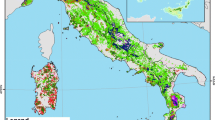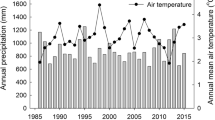Abstract
Accurately estimating forest net primary productivity (NPP) plays an important role in study of global carbon budget. A NPP model reflecting the synthetic effects of both biotic (forest stand age, A and stem volume, V) and climatic factors (mean annual actual evapotranspiration, E) was developed for Chinese pine (Pinus tabulaeformis) forest by making full use of Forest Inventory Data (FID) and dynamically assessing forest productivity. The NPP of Chinese pine forest was estimated by using this model and the fourth FID (1989–1993), and the spatial pattern of NPP of Chinese pine forest was given by Geography Information System (GIS) software. The results indicated that mean NPP value, of Chinese pine forest was 7.82 t m−2·a−1 and varied at the range of 3.32–11.87 t hm−2·a−1. NPP distribution of Chinese pine forests was significantly different in different regions, higher in the south and lower in the north of China. In terms of the main distribution regions of Chinese pine, the NPPs of Chinese pine forest in Shanxi and Shaanxi provinces were in middle level, with an average NPP of 7.4 t hm−2·a−1, that in the southern and the eastern parts (e.g. Shichuang Hunan, Henan, and Liaoning provinces) was higher (over 7.7 t hm−2·a−1), and that in the northern part and western part (e.g. Neimenggu and Ningxia provinces) was lower (below 5 t hm−2·a−1). This study provides an efficient way for using FID to understand the dynamics of foest NPP and evaluate its effects on global climate change.
Similar content being viewed by others
References
Brown, S.L. and Schroeder, P.E. 1999. Spatial patterns of aboveground production and mortality of woody biomass for eastern U.S. forest [J]. Ecological Applications,9(3): 968–980.
Chen Lingzhi, Ren Jihai, Bao Xiancheng,et al. 1984. Studies on the sociological characteristic and biomass of pine plantation on Xishan in Beiling [J]. Acta Phytoecologica Et Geobotanica Sinica,8(3): 173–181.
Cihlar, J., Denning, A.S., and Gosz, J. (Eds.). 2000. Giobal terrestrial carbon observations: Requirements, present status and next steps. Report of a Synthesis Workshop, 8–11 February 2000, Ottawa, Canada. 101 p. Available at Http://www.ccrs.nrcan.gc.ca/ccrs/eduref/ref/biblioe.html.
Curran, P.J. and Foody, G.M. 1994. Environmental Issues at regional to global scales [C]. In: Food, G.M., and Curran, P.J. (eds) Environmental Remote Sensing from Regional to Global Scales. Wiley and Sons, Chichester, PP: 1–7.
Dong, Shiren and Guan Yuxiu. 1980. Studies on productivity ofPinus tabulaeformis stands in Talyue mountain, Shanxi province [J]. Journal of Beijing Forestry University, (1):1–20.
Duvigneaud, P. 1987. La synthèse ècologique [C]. In: Chinese, Y. Li, translator, Beijing, China: Chinese Science Press, pp.82.
Fang Jingyun, Liu Guohua and Xu Shongling. 1996. Biomass and net production of forest vegetation in China [J]. Acta Ecologica Sinica,16 (4): 497–508.
Fang, J.Y., Chen, A.P., Peng, C.H.,et al. 2001. Changes in forest biomass carbon storage in China between 1949 and 1998 [J]. Science,292: 2320–2322.
Fang Jingyun, Liu Guohua and Xu Songling. 1998. Forest biomass of China: an estimation based on the biomass-volume relationship [J]. Ecological Applications,8(4): 1084–1091.
Forest Ministry of China. 1994. Summary of forest resources in China (1989–1993) [M]. Beijing, China: China Forestry Publishing House, 68–90.
Gao Jiarong. 1987. Studies on the nutrient cycling ofPinus tabulaeformis in Huoditang, Qinling [J]. Journal of North-west Forestry University,2(1): 23–35.
Gilmanov, T.G., Parton, W.J. and Ojima, D.S. 1997. Testing the “Century” ecosystem level model on data sets from eight grassland sites in the former USSR representing a wide climate/soil gradient [J]. Ecological Modeling,96(2): 191–210.
Goodale, C.L., Apps, M.J., Birsdey, R.A.,et al. 2002. Forest carbon sinks in the northern hemisphere [J]. Ecological Applications,12(1): 291–299.
Grame M., Hall, J., Susank, W.,et al. 2001. Stragies to estimate national forest carbon stocks from inventory data: the 1990 New Zealand baseline [J]. Global Change Biology,7(4): 389–403.
Guan Yuxiu and Dong Shiren 1986. Studies on Ecosystem ofPinsu Tabulaeformis Plantations (D) A comparison of productivity between the stands in Taiyue, Shanxi Province, and that in Chengde, Hebei Province [J]. Journal of Beijing Forestry University,1: 1–10.
IGBP Terrestrial Carbon Working Group. 1998. The terrestrial carbon cycle: Implication for the Koyoto Protocol [J]. Science,280: 1393–1394.
Jiang, H., Apps, M.J., Zhang, Y.L.,et al. 1999. Modelling the spatial pattern of net primary productivity in Chinese forests [J]. Ecological Modelling,122(3): 275–288.
Lefsky, A.S., Harding, D., Cohen, W.B.,et al. 1999. Surface lidar remote sensing of basal area and biomass in deciduous forests of eastern Maryland, USA [J]. Remote Sensing and Environment,67(1) 83–98.
Lieth, H. 1977. Modeling the primary productivity of the world [C]. In: Lieth H, & R.H. Whittaker eds. Primary Productivity of the Biosphere. New York: Spring-Verlag, 237–263.
Liu Chunjiang, 1987. Study on the biomass and nutrient cycling of the mixed plantation ofPinus tabulaeformis andQuercus variabilis in Xishan region, Beijing [J]. Journal of Beijing Forestry University,9(1), 1–10.
Luo Tianxiang, Li Wennua and Zhao Shidong, 1999, Productivity distribution on patterns and modeling ofPinus taulaeformis in China [J]. Chinese Journal of Applied Ecology,10(3): 257–261.
Luo Tianxiang 1996. Patterns of net primary productivity for Chinese major forest and its matnematical models [D]. Doctor of National Sciences Thesis Dissertation No. S718550, Commission for Integrated Survey of Natural Resources Chinese Academy of Sciences Beijing, p185.
Ma Qinyan. 1987. A study on the biomass of individual tree and stand ofPinus tabulaeformis in Inner Mongolia [J]. Journal of Inner Mongolia Forestry College, (2): 13–22.
Ma Qinyan, 1989. A study on the biomass of Chinese pine forests [J]. Journal of Beijing Forestry University,11(4): 1–10.
Ma Qinyan. 1988. A study on biomass and primary productivity of Chinese Pine (Pinus tabulaeformis carr) [D]. Doctor of National Sciences Thesis Dissertation, Department of Forestry, Beijing Forestry University, Beijing.
McGuire, A.D., Joyce, L.A., Kicklighter, D.W.et al. 1993. Productivity response of climax temperate forests to elevated temperature and carbon dioxide: a North American comparison between to global models. Climatic Change,24(3): 287–310.
Means, J.E., Acker, S.A., Harding, D.J.,et al. 1999. Use of large-footprint scanning lidar to estimate forest stand characteristics in the Western cascades of Oregon [J]. Remote Sensing and Environment,67(3): 298–308.
Melillo, J.M., McGurie, A.D., Kicklighter, D.W.,et al. 1993. Global climate change and terrestrial net primary production [J]. Nature,363: 234–240.
Murillo, J.C.R. 1997. Temporal variations in the carbon budget of forest ecosystems in Spain [J]. Ecological Applications,7(2): 461–469.
Peng, C.H. and Apps, M.J. 1997. Contribution of China to the global carbon cycle since Last Glacial maximum: reconstruction from palaoevegetation maps and an empirical biosphere model [J]. Tellus49B(3): 393–408.
Running, S.W. and Gower, S.T. 1991. Forest—BGC, a general model of forest ecosystem processes for regional applications, Dynamic allocation and nitrogen budget [J]. Tree Physical,9(2): 147–160.
Schmiel, D.S., House, J.I., Hibbard, K.A.,et al., 2001. Recent patterns and mechanisms of carbon exchange by terrestrial ecosystems [J]. Nature,414:169–172.
Schroeder, P., Brown, S., Birdsey J.M.R.,et al. 1997. Biomass estimation for temperate broadleaf forests of the US using inventory data [J]. Forest Science,43(2): 424–434.
Turner, D.P., Koepper, G.J., Harmon, M.E.,et al. 1995. A carbon budget for forests of the conterminous United States [J]. Ecological Applications,5(2): 421–436.
Uchijima, Z. and Seino, H. 1985. Agroclimatic evaluation of net primary productivity of natural vegetation. (1) Chikugo model for evaluating net primary productivity [J]. J. Agr. Meteor.,40(3): 343–352.
Uchijima, I. and Seino, H. 1988. Probable effect of CO2-induced climatic change on agrocliamtic resources and net primary productivity in Japan [J]. Bull. Natl. Inst. Agro. Environ. Sci.,4(1): 67–88.
Wang Huimin, Zhou Guangsheng, Wei Lin,et al. 1995. NPP pattern of Chinese pine forest and its response to climate change [J]. Chinese Bulletin of Botany,12(sup.): 102–108.
Whittaker, R.H. and Likens, G.E. 1975. Methods of assessing terrestrial productivity [M]. New York, USA: Springer-Verlag. 305–328.
Xiao Yu. 1987. Correlation analysis between productivity of ChinesePinus tabulaeformis plantations and ecological factors in Shaanxi Province [J]. Acta Botanica Sinica,29(5): 549–555.
Xu Huacheng. 1993.Pinus tabulaeformis [M]. Beijing Science Press, 41–53.
Zhang Bolin, 1992. Preliminary report on productivity ofPinus tabulaeformis plantation in Weibei Region [J]. Journal of Northwest Forestry College,7(1): 64–67.
Zhang Xinshi. 1993. The potential evapotranspiration (PE) index for vegetation and vegetation-climatic classification (└)—An introduction of main methods and PEP program [J]. Acta Phytoecol Geobot Sin,17(2): 97–109 (in Chinese).
Zhao Shidong and Luo Tianxiang 1998. Approach to the regional scale bio-productivity of terrestrial ecosystem [J]. Resources Science,20(1): 24–34.
Zhou Guangsheng, Wang Yuhui, Jiang Yanling,et al. 2002. Estimating biomass and net primary production from forest inventory data: a case study of China'sLarix forest [J]. Forest Ecol. Manag.,169(2): 149–157.
Zhou Guangsheng and Zhang Xinshi. 1995. A natural vegetation NPP model [J]. Acta Phytoecologica Sinica,19(3): 193–200.
Zhou Guangsheng and Zhang Xinshi. 1996. Study on Chinese climate-vegetation relationship [J]. Acta Phytoecologica Sinica,20(2): 113–119.
Author information
Authors and Affiliations
Corresponding author
Additional information
Foundation item: This study was supported by the National Natural Science Foundation of China (Nos. 30028001, 49905005), National Key Basic Research Specific Foundation (G1999043407); the Chinese Academy of Sciences (KSC2-1-07).
Biography: ZHAO Min (1973-), female, Ph. D. in Laboratory of Quantitative Vegetation Ecology, Institute of Botany, the Chinese Academy of Sciences, Beijing 100093, P. R. China.
Responsible editor: Zhu Hong
Rights and permissions
About this article
Cite this article
Min, Z., Guang-sheng, Z. A new methodology for estimating forest NPP based on forest inventory data—A case study of Chinese pine forest. Journal of Forestry Research 15, 93–100 (2004). https://doi.org/10.1007/BF02856741
Received:
Issue Date:
DOI: https://doi.org/10.1007/BF02856741
Keywords
- Forest NPP
- Forest inventory data
- Chinese pine forest
- Climatic and biotic NPP model
- Spatial distribution pattern




